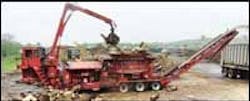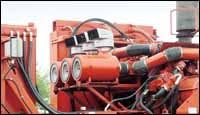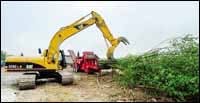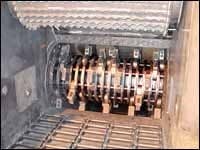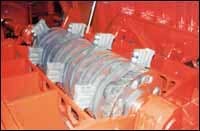Two Ferocious Grinders Work Together
|
Watch a tub grinder at work, and a descriptive adjective that comes to mind is "ferocious." With seemingly little effort, it reduces great volumes of organic debris — massive logs, thick stumps or railroad ties — into neat piles of chips. The "tub" started life some 40 years ago processing silage on farms, but as landfill space has dwindled and pressure to recycle has intensified, tub grinders have taken on more robust designs for handling the toughest materials. And so have designs of a more recent type of grinder, the "horizontal" — every bit as ferocious as the tub. Along the way, a debate of sorts has developed about which type, tub or horizontal, works best — and where.
What better way to get at some potential answers to these questions, than to visit a business that successfully employs both types? That brought Construction Equipment to St. Louis Composting in Valley Park, Mo., where we spent a day with owner Patrick Geraty and operations manager Terry Hennessey. Also on hand to help us understand the technical aspects of grinding machines was Chad Florian, regional sales manager for Morbark, a grinder manufacturer headquartered in Winn, Mich.
St. Louis Composting got its start in 1992, shortly after passage of Missouri Senate Bill 530, which prohibited yard waste from being deposited in landfills.
"When the ban on yard waste went into effect in 1990," says Geraty, "I had a landscaping company, and I began thinking about what was going to happen to all the waste that my company and others like it were generating."
As often happens with those having an entrepreneurial bent, Geraty's thinking led to action, and he negotiated with a landfill owner to process yard waste as an on-site subcontractor. He bought a small grinding machine that could handle logs up to about 8 inches in diameter, because anything larger than 6 inches could still be placed in the landfill.
"After two or three years of processing yard waste," says Geraty, "we had accumulated a mountain of chunk wood that was too large for our machine. We rented a tub grinder to process the material — for a month, we thought — but contractors heard we had the machine and asked us to clean up after their land-clearing operations. We subsequently purchased the machine and used it, in fact, until we traded it last year on a new horizontal grinder."
In 1994, St. Louis Composting bought the 26-acre Valley Park landfill where it had been working as a subcontractor, and the site is now the company's headquarters facility. In addition to its base operation, the company also has a yard-waste grinding operation in Maryland Heights, Mo., and a composting operation in Belleville, Ill. The volume of organic waste the company processes has swelled from the 18,000 cubic yards handled in 1992, to the current volume of around 325,000 cubic yards.
The company's current grinder fleet includes three tubs — all Morbark 1300s — as well as four horizontals, a Morbark 4600, two Morbark 6600 Wood Hogs and a Peterson Pacific 5400. Supporting the grinders are 11 wheel loaders — 10 Caterpillars (eight 950s, a 962 and an IT14) and a Kawasaki 85; two hydraulic excavators, both Caterpillar, a 320 and a 322; four Wildcat trommel screens; a Frontier windrow turner (used to agitate compost); and a Rockland stump splitter. On-road equipment includes 11 "walking floor" trailers, each with a capacity of 80 to 90 cubic yards, and a dozen Mack highway tractors.
St. Louis Composting's business has essentially grown in three directions: processing material from yard-waste haulers; grinding chunk wood for municipalities that have their own yard-waste/composting sites; and processing debris for land-clearing contractors. The land-clearing business, last year, amounted to handling debris from about 500 acres.
Until fairly recently, the company used only tub grinders in its operations. The first horizontal grinder didn't arrive until early 2003 (the Morbark 4600), and then two more followed last summer (the Morbark 6600s). Says Geraty, two basic concerns prompted acquisition of the horizontals: safety and lower processing costs.
Safety is an issue at the Valley Park facility, where civilization is encroaching on its chunk-wood processing operation.
"Unless we're working in the far, far corner of our site," says Geraty, "we use the horizontal, because the tub has the propensity to throw debris. But when we do use the tub, we make it a practice to cover it at the end of a grinding cycle, when the chance of throwing debris is the greatest."
On land-clearing projects, however, where safety is always important but less of an issue, the company uses both tubs and horizontals. How the machines are employed is basically a function of job size.
"We find that on smaller jobs, say, three acres or less, we can send out a tub and work efficiently," says Geraty. "It can handle everything on site — stumps and chunks, included — with no problem. On larger, jobs, though, we've developed a processing sequence that involves both a horizontal and a tub, and this technique is helping us control costs."
On these larger jobs, after the land-clearing contractor has the big stuff down, St. Louis Composting's crew works with a logger, who removes any logs having commercial value — whether for lumber, pallet wood or pulp. After the logger leaves, the company brings in a horizontal to grind the remaining tops, which are pushed up to the grinder by the land-clearing contractor, then fed into the grinder by one of St. Louis Composting's grapple-equipped excavators.
Although the horizontal is capable of processing material up to 18 inches in diameter, says Geraty, it loses production efficiency if asked to do so, because "it takes a while to chew on the large chunks." For chunk wood and stumps on big jobs, the company typically brings in a tub.
"This arrangement has helped tremendously in lowering our cost per acre," says Geraty. "With the previous method, using only a tub on large jobs, everything had to be cut into 8-foot lengths [to prevent material from tipping out of the tub]. This usually required at least two people with chain saws. On a big job, you could rack up a lot of labor in saw work."
Geraty illustrates the process of using two machines with an example from a recent 42-acre job.
"After the logger took what he wanted, we ground the rest in eight days with a horizontal," he says, "then came in with a tub for three days and finished up. We never picked up a chain saw. The horizontal's strong point is that you can eliminate saw work. So in combination, the two types of grinders work well together."
But, that said, Geraty believes the horizontal has the edge over a comparably rated tub on two counts: overall productivity and the ability to work in confined areas.
"A good day for a tub grinder is about 14 semi loads of chips," he says. "But our record for a horizontal is 28 loads. The horizontal also allows us to work in tighter situations, alongside buildings and parking lots, without having to worry about throwing debris. But everything considered, utilization between the horizontals and tubs is about the same."
When we asked Geraty how St. Louis Composting decides on a grinder size, given the wide range of models available, he said that decision attempts to balance the productivity of the machine with its transportability. Ease of transporting is important to the company because, on average, at least one grinder moves every day.
"We chose the model 1300 tub grinders over Morbark's larger models, for example, to simplify the issues of trucking and permitting," he says. "The 1300s are permit-loads, of course, but still easier to move than a larger machine. Productivity-wise, they probably do about 85 percent of what the larger grinder does."
Although size differs, the components that actually process debris through a tub or horizontal grinder, namely the hammer mill and screens, are essentially identical in design between the two types. The hammer mill is a drum-like structure that has "hammers" pinned to its outer surface. Each hammer accommodates a bolt-on insert, which actually engages the material being processed.
Comparing the hammer mills for the Morbark 1300 tub and 6600 horizontal, the former's mill is 20 inches in diameter and 54 inches wide, while the 6600's hammer mill is 28 inches in diameter and 67 inches wide. The 1300's mill is fitted with 14 hammers, and the 6600's can accommodate up to 30. Horizontals in the St. Louis Composting fleet are fitted with 18 hammers, which yields optimum production in its operations. Both types of grinders used in pioneer operations (not regrinding) are equipped with 5-inch screens. These grate-like screens, which have openings of 5 inches, partially surround the mill and size the processed material. Oversize material remains in this grinding chamber of sorts until it can pass through the screen.
In the tub grinder, the mill is positioned at the bottom of the tub, and material feeds into the mill via gravity. The 6600 horizontal grinders, however, use a positive feed system that includes an input conveyor (along the floor of the hopper) and a hydraulically driven feed wheel just above the hammer mill.
When a grapple-equipped excavator places material, such as whole trees, on the horizontal grinder's conveyor, the material is pulled toward the mill, then forcefully pushed against the mill by the feed wheel. According to Morbark, its Iqan feed system is designed to automatically adjust feed rates, pressures, and feed-wheel position to optimize production and engine efficiency.
The model 6600 Morbark horizontal grinders used by St. Louis Composting are fitted with 1,000-hp engines, and the model 1300 tub grinders are rated at 860 horsepower. Both types, however, utilize a hydraulic clutch and gearbox between the engine and the hammer mill. The 1300's hammer mill is shaft-driven from the gearbox, while the 6600's mill is belt-driven. Engines and drive trains in both machines are protected with Morbark's "break-away torque limiter," which, says the company's Florian, is a system of adjustable detent mechanisms, positioned between rotating members, that will pop out of index if torque requirements exceed a pre-set value.
For those of you who may be wondering about the life expectancy of grinders, given the arduous work they do, Morbark's Florian estimates that most machines, tubs and horizontals alike, are traded at between 6,500 and 8,000 hours. The most usage he's seen on a machine was 10,000 hours. What happens to grinders that have reached the end of their economic life? Speaking for the Morbark line, Florian says that many of them are refurbished.
"When a grinder is refurbished," says Florian, "the engine is sent out for rebuilding, and the remainder of the work is done at the Morbark factory. In general, refurbished units of the size St. Louis Composting is using have a list price of $350,000 to $370,000, compared to around $480,000 to $490,000 for a comparable new unit. Generally, the refurbished machine will provide as many hours as a new unit."
